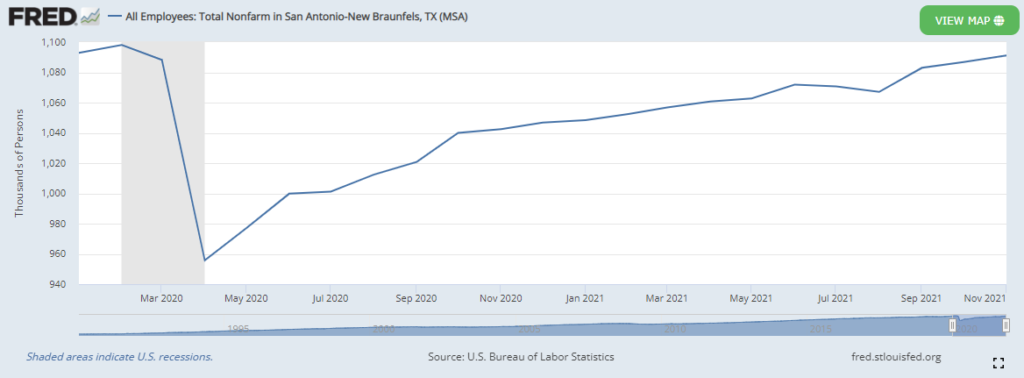Local Media Does Citizens Disservice By Avoiding Balance

Newspaper editorial pages generally lean one way or another politically. Given that they’re made up of individuals with their own leanings, this is no surprise.
However, even though the New York Times and Wall Street Journal tend to sway left and right, respectively, each have columnists that go against that grain, providing some semblance of balance. If that characteristic has trickled down to local outlets, it missed us here in the Alamo City.
What we have is a media that leans one way, unchecked. They leverage this to essentially promote government programs, and sugarcoat their inevitable failure. History is no guide to them.
The latest example revolves around San Antonio’s “Train for Jobs” (TfJ) program, which itself is a precursor to the “Ready to Work” (RtW) initiative. The San Antonio Express-News editorial defending it contains slants, omissions, and the failure to connect some dots.
The Slants:
“When COVID-19 brought San Antonio’s economy to a standstill …“
The popular narrative, from the international level down to the local, is that the coronavirus/COVID-19/pandemic caused the massive recession last year. That is not the case, and we’ll never know for sure the extent to which it was responsible.
Businesses were starting to stock (more) hand sanitizer. Those in charge could be found wiping down door handles. People were making adjustments. It was the primitive government lockdowns that sent society and the economy into a tailspin.
Whenever we hear of Wall Street gyrating because of a new variant, it’s not the virus they’re reacting to. From Warren Buffet to the casual day-trader, people putting their resources at risk do so with the utmost diligence. They’re generally not dumb people.
Most of us, investors or not, know from life experience that viruses mutate, especially as we adapt to them, bolster our immune systems, update vaccines, etc. What is more difficult to predict is the collective wisdom, to use a term loosely, of officeholders that today’s politics tends to produce.
The reaction of governments at every level to the coronavirus, regardless of the political party in charge, is merely the latest example of what usually causes such a “standstill.”
“That said, a Dec. 15 city report offers optimism. More than 16K people have expressed interest in the program, more than 9,500 people have completed the intake process, and more than 4,400 people have enrolled.“
A right-leaning publication might just as easily have substituted “cause for concern” for “optimism,” and rounded the figures up to the nearest thousand in order to use “less than” rather than “more.” “Roughly” would have been the most objective word here.
The Omissions:
”Consider the cost of the status quo — unemployment …”
“The job training was launched in the middle of the pandemic, in spring 2020, when 140K city residents found themselves out of work. It’s a different job market today. “
The EN does not elaborate on this last point, so we will:

The employment situation in San Antonio is approaching where it was before the government shutdowns. As the EN reports, roughly 900 of those jobs can be attributed to the TfJ program. The disparity is obvious.
What explains it? Actual job creators do, not to mention the pre-existing educational infrastructure. The former already “invests in people” via training, while the latter regularly “revamps our workforce.”
Nevertheless, despite the early, lackluster returns of the federally-funded TfJ, San Antonio mayor Ron Nirenberg led activists in convincing three-quarters of voters to commit a portion of sales tax revenue to the RtW program.
Why? Do they believe the efforts of employers and schools, with whom they’re reportedly partnering in this venture, to be inadequate? Was it simply a quest for a ‘political victory’?
Do they believe in government dependence i.e. “wraparound services”? Was it redirect more taxpayer money to other public institutions (colleges) as a favor? In this case, it arguably adds fuel to the tuition-inflation fire. Shouldn’t leaders, not to mention the press, know all this?
The result is a huge deadweight loss to society to benefit the well-connected.
Connecting the dots:
”The city also was slow to set up it (sic) internal structure and only hired a permanent director … in August.”
”Be critical of the city’s workforce efforts, but also be patient. Generational change takes time.”
Government faces next to no threat of going out of business, even when it encounters competition. It lacks the incentive that drives their stiffest rivals (postal delivery, education, book stores) to succeed: the profit motive.
Private entities in these sectors have found a way to deliver higher quality at acceptable prices even as their customers continue to be poached via taxation to finance the public options. That’s how inadequate the latter are.
Nonetheless, since these public bodies aren’t going anywhere, they face less pressure to deliver a valuable service in a timely manner. And the people running them know it.
So do others eager to jump on the gravy train.
Lifetime politicians, bureaucrats and activists who advocate for/run government programs have little inclination to promote private alternatives. They have every motivation however, to convince voters to pay a ‘tiny’ fraction more in taxes for another government program.
An objective media would point all this out.
[…] those areas, the voting public is urged to have patience for another failed government program that rested on faulty premises to begin with. Or, cues are taken from national talking points to redefine “public art … […]